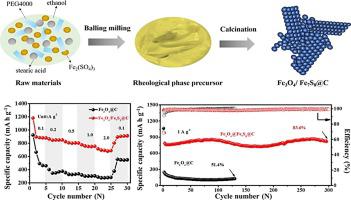当前位置:
X-MOL 学术
›
Mater. Res. Bull.
›
论文详情
Our official English website, www.x-mol.net, welcomes your
feedback! (Note: you will need to create a separate account there.)
Rapid in-situ fabrication of Fe3O4/Fe7S8@C composite as anode materials for lithium-ion batteries
Materials Research Bulletin ( IF 5.3 ) Pub Date : 2021-01-01 , DOI: 10.1016/j.materresbull.2020.111021 Hai Tian , Zhenguo Wu , Yanjun Zhong , Xiushan Yang , Xiaodong Guo , Xinlong Wang , Benhe Zhong
Materials Research Bulletin ( IF 5.3 ) Pub Date : 2021-01-01 , DOI: 10.1016/j.materresbull.2020.111021 Hai Tian , Zhenguo Wu , Yanjun Zhong , Xiushan Yang , Xiaodong Guo , Xinlong Wang , Benhe Zhong

|
Abstract Fe3O4 is currently one of the research hotspot of anode materials used in lithium-ion batteries because of its high theoretical lithium storage capacity, abundant in nature, low cost and environmental-friendly. However, problems such as poor electron conductivity and large volume change during lithium transfer often lead to deterioration of electrochemical performance which limits their practical application. Here, with a designed composite of Fe3O4/Fe7S8 supported by carbon skeleton, we used a facile and rapid rheological phase method to realize the in-situ construction of the Fe3O4/Fe7S8@C composites. The as-prepared composite shows three-dimensional (3D) interlaced lamellar structure self-assembled by nanoparticles with size of dozens of nanometers. Electrochemical measurements results inferred that the electrode displays better comprehensive electrochemical performance than conventional Fe3O4@C sample. For example, it delivers a reversible discharge capacity of 819 mAh g-1 at 1 A g-1 after 300 cycles and a capacity retention rate up to 83.6%. This is mainly due to the unique 3D interlaced lamellar structure and the support of carbon skeleton, which inhibits the volume change during lithium storage process. In addition, the presence of sulfide provides additional capacity and promotes the reaction kinetics. In view of the cost-effective feedstock and the convenience of preparation, this study provides an extensible strategy for advanced Fe3O4 anode materials of lithium-ion batteries.
中文翻译:

Fe3O4/Fe7S8@C复合材料作为锂离子电池负极材料的快速原位制备
摘要 Fe3O4具有理论储锂容量高、储量丰富、成本低、环境友好等优点,是目前锂离子电池负极材料的研究热点之一。然而,锂转移过程中电子传导性差、体积变化大等问题往往导致电化学性能的恶化,限制了其实际应用。在这里,通过设计的由碳骨架支撑的 Fe3O4/Fe7S8 复合材料,我们使用一种简便快速的流变相法实现了 Fe3O4/Fe7S8@C 复合材料的原位构建。所制备的复合材料显示出由几十纳米大小的纳米粒子自组装的三维 (3D) 交错层状结构。电化学测量结果推断该电极显示出比传统 Fe3O4@C 样品更好的综合电化学性能。例如,它在 1 A g-1 循环 300 次后提供 819 mAh g-1 的可逆放电容量和高达 83.6% 的容量保持率。这主要是由于独特的3D交错层状结构和碳骨架的支撑,抑制了锂存储过程中的体积变化。此外,硫化物的存在提供了额外的容量并促进了反应动力学。鉴于原料的成本效益和制备的方便性,本研究为锂离子电池先进的Fe3O4负极材料提供了一种可扩展的策略。它在 1 A g-1 循环 300 次后提供 819 mAh g-1 的可逆放电容量和高达 83.6% 的容量保持率。这主要是由于独特的3D交错层状结构和碳骨架的支撑,抑制了锂存储过程中的体积变化。此外,硫化物的存在提供了额外的容量并促进了反应动力学。鉴于原料的成本效益和制备的方便性,本研究为锂离子电池先进的Fe3O4负极材料提供了一种可扩展的策略。它在 1 A g-1 循环 300 次后提供 819 mAh g-1 的可逆放电容量和高达 83.6% 的容量保持率。这主要是由于独特的3D交错层状结构和碳骨架的支撑,抑制了锂存储过程中的体积变化。此外,硫化物的存在提供了额外的容量并促进了反应动力学。鉴于原料的成本效益和制备的方便性,本研究为锂离子电池先进的Fe3O4负极材料提供了一种可扩展的策略。硫化物的存在提供了额外的容量并促进了反应动力学。鉴于原料的成本效益和制备的方便性,本研究为锂离子电池先进的Fe3O4负极材料提供了一种可扩展的策略。硫化物的存在提供了额外的容量并促进了反应动力学。鉴于原料的成本效益和制备的方便性,本研究为锂离子电池先进的Fe3O4负极材料提供了一种可扩展的策略。
更新日期:2021-01-01
中文翻译:

Fe3O4/Fe7S8@C复合材料作为锂离子电池负极材料的快速原位制备
摘要 Fe3O4具有理论储锂容量高、储量丰富、成本低、环境友好等优点,是目前锂离子电池负极材料的研究热点之一。然而,锂转移过程中电子传导性差、体积变化大等问题往往导致电化学性能的恶化,限制了其实际应用。在这里,通过设计的由碳骨架支撑的 Fe3O4/Fe7S8 复合材料,我们使用一种简便快速的流变相法实现了 Fe3O4/Fe7S8@C 复合材料的原位构建。所制备的复合材料显示出由几十纳米大小的纳米粒子自组装的三维 (3D) 交错层状结构。电化学测量结果推断该电极显示出比传统 Fe3O4@C 样品更好的综合电化学性能。例如,它在 1 A g-1 循环 300 次后提供 819 mAh g-1 的可逆放电容量和高达 83.6% 的容量保持率。这主要是由于独特的3D交错层状结构和碳骨架的支撑,抑制了锂存储过程中的体积变化。此外,硫化物的存在提供了额外的容量并促进了反应动力学。鉴于原料的成本效益和制备的方便性,本研究为锂离子电池先进的Fe3O4负极材料提供了一种可扩展的策略。它在 1 A g-1 循环 300 次后提供 819 mAh g-1 的可逆放电容量和高达 83.6% 的容量保持率。这主要是由于独特的3D交错层状结构和碳骨架的支撑,抑制了锂存储过程中的体积变化。此外,硫化物的存在提供了额外的容量并促进了反应动力学。鉴于原料的成本效益和制备的方便性,本研究为锂离子电池先进的Fe3O4负极材料提供了一种可扩展的策略。它在 1 A g-1 循环 300 次后提供 819 mAh g-1 的可逆放电容量和高达 83.6% 的容量保持率。这主要是由于独特的3D交错层状结构和碳骨架的支撑,抑制了锂存储过程中的体积变化。此外,硫化物的存在提供了额外的容量并促进了反应动力学。鉴于原料的成本效益和制备的方便性,本研究为锂离子电池先进的Fe3O4负极材料提供了一种可扩展的策略。硫化物的存在提供了额外的容量并促进了反应动力学。鉴于原料的成本效益和制备的方便性,本研究为锂离子电池先进的Fe3O4负极材料提供了一种可扩展的策略。硫化物的存在提供了额外的容量并促进了反应动力学。鉴于原料的成本效益和制备的方便性,本研究为锂离子电池先进的Fe3O4负极材料提供了一种可扩展的策略。











































 京公网安备 11010802027423号
京公网安备 11010802027423号